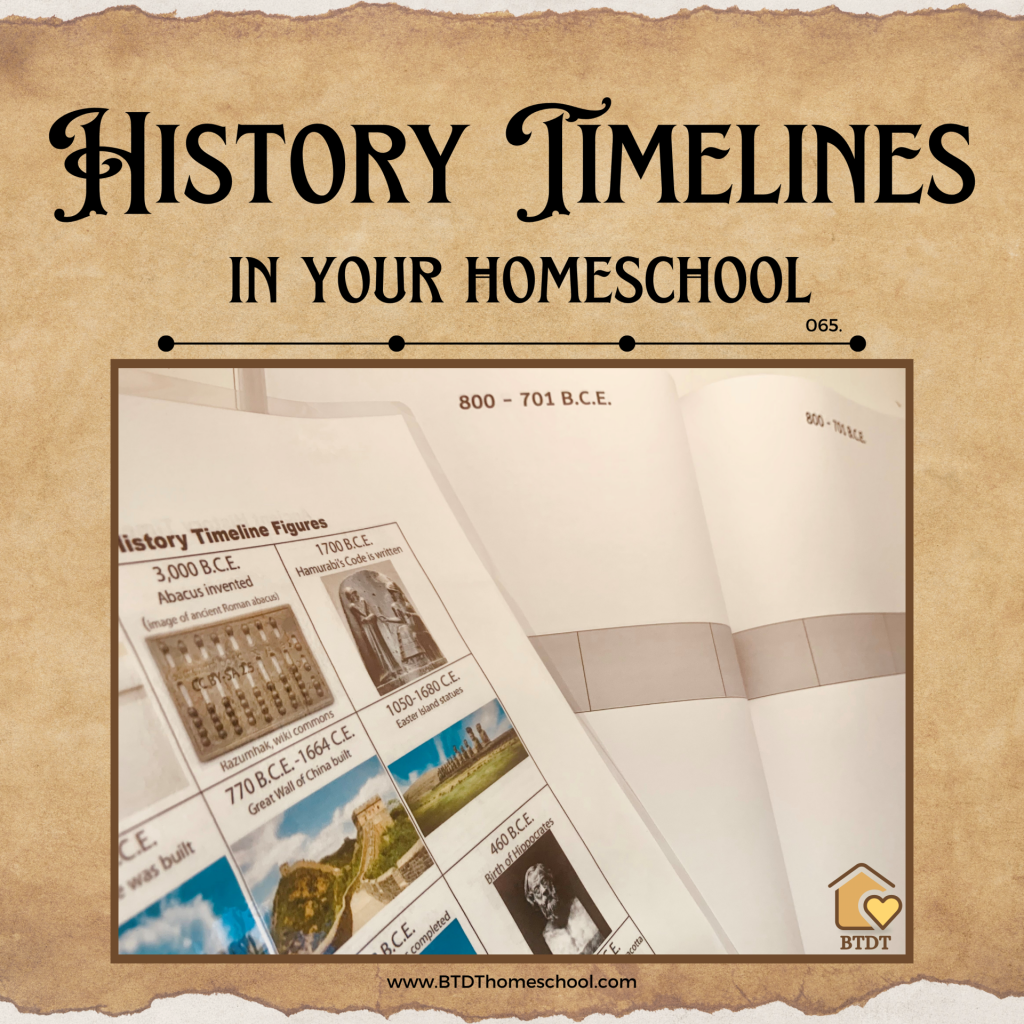Planning Your Homeschool Year
Does the idea of planning your next school year stress you out? Are you wondering if you need to teach every subject or how to organize your homeschool room? Tune in this week as we dive into these topics and more! Whether you’re bored with your current curriculum, ready to try something new, or brand new to homeschooling, we’ve got the tips and inspiration you need to make your homeschool year a success. Plus, don’t miss out on our freebie this week to help you plan!

Episode 031:
TWO WAYS TO LISTEN TO THIS EPISODE:
1. Click PLAY Button Above ^^ to listen here.
2. OR Listen on your favorite podcast platform:
Scroll down for this week’s FREEBIE:
Homeschool Planner Templates! (pdf)
Brand New to Homeschooling?
GETTING START PAGE >>
Kindergarten Page >>
High School Series >>
Show Notes
We are getting to that time of year! Some of us are bored with our current curriculum or program and ready to move on to the next level or try something new. Some of you might be brand new to the idea of homeschooling and organizing your school year. If you follow a traditional homeschool schedule, you may be counting down the days until summer break. Some of us may be stressed out because our friends are asking which class we all want to do together in the fall, and we are still thinking about next week.

Homeschool planning can seem like an overwhelming endeavor—especially if you’re not sure where to start. In this episode, we are going to help you to feel confident as you embark on your homeschool journey and help you to organize your year. We’ve compiled some helpful insights to make this process more simple and stress-free to create a solid homeschool plan for the upcoming school year.
Here are some great ways to jump into your planning in a simple, non-stress way:
1. Create a Mission Statement
Before you dive deep into creating an entire homeschool plan, we encourage you to reflect on the reason you chose homeschooling for your family. From there, you should develop a mission statement, which is a long-term overarching vision for your homeschooling journey. This statement should be rooted in your key values and apply to everyone involved. For example: “To instill creativity, curiosity, and a love of learning through meaningful educational experiences both at home and in the world.”
2. Set Student Goals
Now that you’ve established your “why” for homeschooling, you can move on to setting goals for each child. Goals are more specific, measurable, and time-bound objectives that you want your kids to accomplish in the year ahead. It’s easy to become overly ambitious when homeschool planning. Having goals will help you prioritize your lessons and keep your students on the right track.

Complete BTDT Homeschool Amazon Wishlist>>
Here are a few quick tips for successful goal-setting:
* Focus on each child’s individual strengths, weaknesses, and interests
* Pick no more than three goals to pursue (too many can get overwhelming)
* Be sure to track progress and revisit goals on a regular basis
Knowing your goals will help you with the next phase of homeschool planning—selecting subjects.

3. Choose Your Subjects
Once you have your goals in mind for each student, you’re ready to choose which subjects to focus on this year. While this may be dictated by the homeschooling laws in your state, there’s usually some room for discretion. Using your state’s regulations and your goals as a guide, write down a list of the subjects you plan to teach each student.
Some people like to stick to the basics: reading, writing, and arithmetic and build from there. If you have high schoolers, you may want to go back to look at your 4 year plan and check off credits.
4. Select Materials
The next step in the homeschool planning process is deciding what educational materials you’re going to use. Before you opt for the first curriculum a friend or group recommends, though, be sure to consider your mission statement, your homeschool style, and your child’s learning style. Having these in mind will help you find the best fit for your family.

We’re going to be diving into choosing curriculum and walking you through that process, but for today as we discuss making a plan and organizing your school year, these are basic things to consider before settling on any school materials:
- Would you prefer a prepackaged, “open-and-go” curriculum from a single publisher?
- Do you work from home? How much parent involvement does the curriculum require?
- What is your child’s learning style? Does your child work well independently? Are they easily distracted and need you there to refocus them?
- Will you find free resources from the internet or library, or adopt an eclectic approach?
- Are there outside opportunities, such as a co-op, online class, or college dual-enrollment that would be a good fit for your child?
- Are you looking for an online school versus traditional homeschooling? This is a good fit for some people. But it can also be restrictive if you want a more flexible schedule to do some of those daytime homeschool activities with friends when you need to be online. Most younger children are typically going to learn better with hands-on interactive learning so you may want to consider limiting too much computer time with those younger years.
- If you are new, you also want to consider your worldview as well as homeschooling style, this will help narrow down choices immensely. We talk about this in our getting started episode.
- If you really want to see the curriculum in person, see if local friends have it, visit a homeschool store. Most people have a lot of luck on YouTube. Almost every curriculum has a YouTube review or you can see it up close

Top 10 Things We Wish We Knew Before Homeschooling.
Remember, if you feel that a certain curriculum doesn’t meet your child’s needs, feel free to switch to something out at any point during the school year! You don’t have to stick with any materials that aren’t working for you. We also suggest choosing flexible curricula so that you can modify the materials however you see fit. I’ve often skipped parts of a lesson that I know was a skill already mastered. So don’t waste time on unnecessary filler. And on the flipside, when something from the lesson really piques your child’s interest, run with it! Spend extra time on that and dive deeper. They are going to enjoy learning and retain information when they are really interested. Remember, one of our ultimate goals is to create lifelong learners. Those moments of curiosity are opportunities.
5. Organize Your Supplies
One of the biggest hindrances to a smooth-running school day is having to waste time looking for necessary supplies. The key to avoiding this? Have a specific spot where all of your school materials are neatly organized.
We encourage you to pick a place in your home that can be the designated “school supply area.” This can be an office space, closet, or even just a corner of the dining room. Then, get a shelf and storage bin for each student so they can easily grab their materials at the start of each day and return them once finished.
6. Develop a Schedule
Creating a schedule is another key aspect of homeschool planning. This ensures that you stay on track and maintain consistency throughout the year. There are a number of questions that you should ask yourself while developing your schedule, including:
- Do you plan on homeschooling year-round, following a traditional academic year, or doing something else entirely?
- How many days will you be schooling each week? Five days? Four?
- Will you be teaching all subjects each day or adopting a loop schedule?
- How many hours do you want to spend doing school work each day? Most people with a traditional school setting tend to be overly ambitious with this. When you have such a small student/teacher ratio you don’t have to spend as much time schooling.
We recommend:
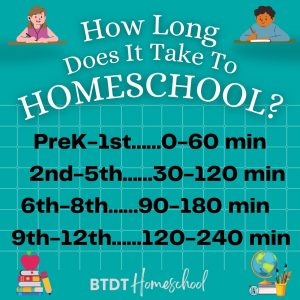
Keep in mind any important obligations, like extracurricular activities or jobs, when establishing your homeschool schedule. Be sure to make room for your non-negotiable fun things, like park days or clubs. Consider your schedule’s big picture, too. I knew that I was always going to have a hard time reining kids in after hiking group or co-op, so those days needed to be otherwise clear, or have one easy thing after. The beauty of homeschooling is having that ability to manage your own time. If you want to stack Monday and hit it hard in order to have a better week, go for it.
7. Embrace Spontaneity
One of the greatest gifts that homeschooling offers is the flexibility to adjust your schedule as you wish. That said, it’s helpful to plan for spontaneity by allocating some breaks in your homeschool plan. Last-minute opportunity for a trip? Go for it! Kids feeling burnt out? Play some hooky and get back into schooling tomorrow—or even next week! If you plan ahead for those spontaneous scenarios, it will allow you the freedom to enjoy some time off or handle unexpected life events without school-related stress. This is one of the reasons that I really love to do school year round. There is no pressure to stick to a calendar.

When should I plan for the next school year? (13:21)
The great news is that your homeschool plan doesn’t have to be fully fleshed out before you can get started. Of course, your goals should be planned before the start of the school year, but try not to get too hung up on this. You are the administrator and can adjust as circumstances change. Having your subject and curriculum plan in advance is also ideal, as it gives you time to become comfortable with your materials. On the other hand, one of the main benefits of homeschooling is having the ability to add or change subjects and curriculum during the school year. So, if you haven’t found that perfect writing program yet, just wait and add that subject in a bit later rather than make an impulsive decision.
When the actual lesson planning happens is a personal decision and that’s up to you. While it isn’t necessary to plan all of your lessons for the year in advance (as things will undoubtedly change), having a rough idea of what you want to cover at certain points throughout the year can be helpful. We suggest doing the actual lesson planning one week in advance. That way, you can easily make adjustments based on appointments, friend hang-outs, field trips, extracurriculars, and so on.
My family is really project-based. Whether I created a curriculum myself or bought it, I always kept a running list of supplies that will be needed on my phone. Sometimes you’ll be too busy to pre-organize and there’s nothing worse than sitting down Sunday night to quickly write out your week and realize that you’re short of an ingredient or a supply for a project or activity. So when I’m at the store, doing my normal shopping, I will glance at my list to make sure I didn’t forget a supply for the upcoming week.
I’m an all or nothing person- sometimes if I plan too much in advance and then get off schedule, I am likely to bag the whole thing! So, rather than do too much and then get all frazzled, taking things in smaller chunks is a better method for me. And you can have a long term plan and short term plan.. Whatever works for you.
The point is, don’t let homeschool planning be a source of anxiety. Take a deep breath and take it one step at a time. One week at a time. You’ve got this!
If you are new to homeschooling, you do have a couple considerations to make as you begin planning. The first thing you’re going to need to do is familiarize yourself with your state’s homeschool requirements. Are there subjects that you are required to teach? Do you need to keep records or work towards an end of year test or portfolio evaluation? Some states have strict requirements, some like ours are very vague.
So you will need to decide if you will (or need to) follow the state’s curriculum outlines or do your own thing.
Are you new because you have an up and coming homeschooler? As you planned, obviously the age of your child is going to matter. If you have a very young student (3-5), learning happens through life and play. This age should be non-pressure, non-stress for learning and is ideal to pick some simple goals – things like life skills, language development, large motor skills (climbing on the playground) and some basic fine motor skills (how to hold a crayon.).
If you’ve not checked out our preschool page, be sure to do that. From there, you can listen to our preschool episode and the page has tons of ideas for facilitating learning through play in your home. We also have a lot of free resources you can download including morning and evening, routine charts, a nature scavenger hunt, and more!
Next, regardless of age or experience, consider putting together a general overview of what you will teach and learn throughout the year. Consider what subjects you want to make sure you cover – like core subjects-math, reading, and writing and what things you personally consider as extras. Involve your child! Ask them and consider their interests and curiosities.
Think about what topics you would like to learn through a unit study. Unit studies are a great alternative, or a complement to a curriculum. They give you an opportunity to pursue an interest or curiosity to wherever it takes you, and this is where some of the best learning happens. I have always favored unit studies. We would incorporate them through the school year but before high school we have always schooled year round with short days and lots of breaks. When our main curriculum was complete, we would deep dive into all kinds of topics. Over the years, some of the unit studies we’ve done:
penguins, civil rights leaders, volcanoes, the light spectrum, space, native American tribes, human anatomy, and more.
Make sure that your goals are developmentally appropriate and personalized to your child. A vision board can be a great way to plan in a creative way and get your kids involved. A lot of homeschoolers like to create a vision board for the year. Involve your kids in this activity! Your child can cut/paste pictures or words of things they want to accomplish or attempt throughout the year. If you don’t want to do a vision board, just brainstorm together on a whiteboard or piece of paper. You can divide it up into sections to focus on, like academics, unit studies, social, physical fitness, financial, personal, etc. This is a great way to see what their goals are, and to help them figure out what steps they need to take to get there. If your child is needing inspiration, they can go to outschool.com and look through courses.
You can go to our electives page on our website and look through some of the “out of the box” ideas for electives. Write a list of favorite topics or subjects they are curious about, then see how you can use these in your school year.
What kind of extracurriculars do you want to be involved in? Board game group, scouts, co-ops, music, lessons, robotics club, book clubs. Does your teenager want to get their driver’s license, a part-time job, a volunteer job? What about an apprenticeship? What about social meet ups? And friend time?
Sometimes I like to do a theme for the entire year. I talked about unit studies a minute ago and this is like an entire school year of unit study. One year we I did an entire American music history year. We learned about American music from the early native, to swing and ragtime to modern hip-hop. We made a leather skinned drum, read books about the Beatles and Scott Joplin, watched Jamie Foxx in the motion picture Ray and visited the rock ‘n’ roll Hall of Fame and Graceland. It was an entire year of a unit study I put together. We still did math, but almost everything else we learned was themed for the year. It’s by far our favorite school year ever.
Homeschooling offers the opportunity to approach learning and teaching differently than the traditional school system. There are lots of educational methodologies that we can choose from – even that we can mix and match from – to provide a very well rounded, thorough learning experience for our child.
Choosing curricula is the one step that tends to overwhelm, panic, and stress people out and can be one of the hardest steps to take while homeschool planning. There are SO many choices out there. There can be too many choices. Going online and searching homeschool curriculum is going to give you over one million results. That’s why we really recommend having some things (like worldview, homeschool style, what kind of materials you prefer) locked down in advance. This will definitely help narrow your options.
We are going to have an episode specifically guiding you on how to choose curricula and we’re also going to be spending a lot of time reviewing and making curriculum suggestions. But in today’s episode, we really want to focus on organizing your calendar and setting up your child for success throughout the school year. You want to spend time figuring out WHAT you want to teach and HOW you want to teach it and this can help narrow down those options.
Timelines have long been used as a visual representation of historical events. Relate subjects together and view historical events as interrelated in your homeschool with our Book of Centuries and Timeline Figures. They are the perfect combination to make history come alive!

Get creative with their courses, projects and hands-on learning. There are also a lot of amazing classes and programs, digital and printable resources, and other unique options to choose from like Outschool or in your community.
We have our own super cool Book of Centuries and timeline figures– those can be a fun way to add in history. On our website, you can find all kinds of resources to help you plan from reading logs, to field trips writing review sheets, and high school documents. Most of it is totally free.
Maria’s Homemade Timeline:


Let’s also talk for a sec about physical planners. I like to spend my Sundays making my Blueprint for a beautiful week~that’s when I lay out my schoolwork, look over our activities and obligations, make my menu plan and grocery list, etc. You can do this anyway you want. And we’ve talked about letting your older kids find the method that works best for them. Our kids are growing up in a much more digital age than we did. They may totally cringe at the idea of a paper system, so be flexible.
Do I have to teach all subjects? (28:20)
People often ask if they need to teach every subject to their child. Again, you need go back to your state’s requirements. Are there subjects that you are required to teach? Do you need to keep records or work towards an end of year test or portfolio evaluation? Most states allow you to make a lot of these decisions, but there are a few that have strict requirements.
Some people also like to keep an eye on what public school standards are for each grade level. We didn’t do this, but it may be something you want to do if you think your child may return to school at some point or if you just want a general idea or where you are.
Here is a very General Overview of what subjects are typically covered in school:
- Languages –English language arts: including reading, writing, grammar, poetry, prose, literature, creative writing, report writing as well as developing oral presentation and reporting skills.
Foreign languages: while typically introduced in high school, you can opt to begin these at any time in your homeschool. We talk about this in our Q&A episode.
- Mathematics – including the basics (adding, subtraction, multiplication, division, fractions, decimals), algebra, geometry, trigonometry, calculus.
- Science – including Biology (plants, animals, human body), Physical sciences (physics, chemistry)
- History – state history, world history and country specific history.
- Geography – including earth sciences, astronomy, regional/cultural studies, map work and weather.
- Technology – including product development, using/interacting with technology (PC, internet, home and kitchen appliances etc.), programming/software.
- Economic sciences – including money management, entrepreneurship, investment, business and management skills (time management, project management).
- Arts – including the practical application (painting, drawing, playing an instrument, theater, dance), appreciation and history of the arts and music environment.
- Life skills – this can include everything else one needs to properly survive in the world e.g. Home maintenance, health and nutrition, first aid, safety skills, relationship skills, communication, conflict handling, study skills, etc.
Some of these subjects you are going to find repeat in some form or fashion every year. There may be specific ones that you save for a certain age or level.
Don’t waste a ton of time trying to teach something to a kindergartener that you can spend 5 minutes explaining to a second grader
So you do not need to teach all subjects, every year. Pick and choose the things that you need to cover, the things you want to cover, and build your overall plan from there.
How do I organize my homeschool room? (33:33)
We have said many times that you really do not need a physical classroom or the perfect pinterest homeschool space to facilitate learning at home. There are all kinds of ways that people creatively fit their homeschooling books and supplies into small spaces and learning does not at all have to happen at a desk or table. Ours often happens on the couch, or in bed. In fact, we’d caution against trying to replicate a school classroom in your home. That can be a waste of time and money. Instead, concentrate on things like making supplies accessible all the time for when inspiration hits. It’s just another way to keep learning fun. Remember, learning doesn’t stop when you close the curriculum, children are learning all the time.
Your learning space will depend on several factors. It will depend on the size of your homeschool space if you have it, how many children you have, and the type of homeschooling you and your family participate in. Check out our TOP 25 Homeschool Essentials:
One of the things I recommend, as well, especially if space is a concern, is having only the items out that you are using in that school year. For a lot of us managing different aged or leveled children, this could mean you have a lot of books and resources going just for that year. Do yourself a favor and stash stuff you are saving for later, or hand me down items for a younger sibling somewhere else and make it part of your yearly planning to rotate things in and out.

Hopefully this episode has put you at ease and has inspired you to start planning your next homeschool year. Homeschool planning does not need to be stressful but it can seem like an overwhelming endeavor. We want you to feel confident as you embark on your homeschool journey.
Peek into Nicole and Maria’s homeschool rooms through the years:
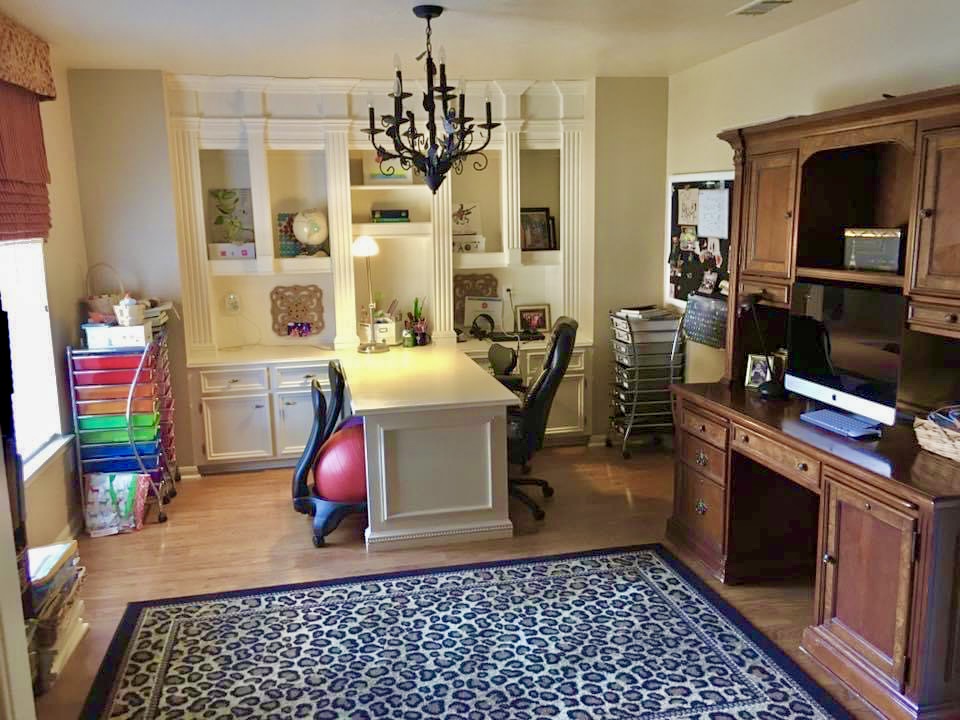
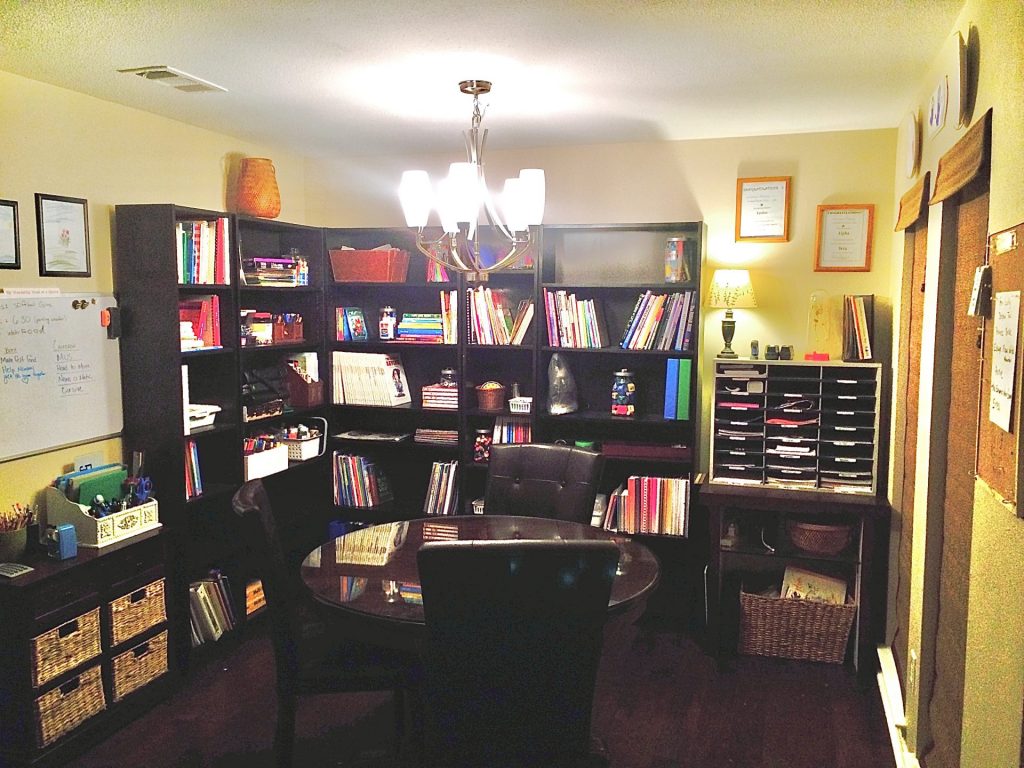
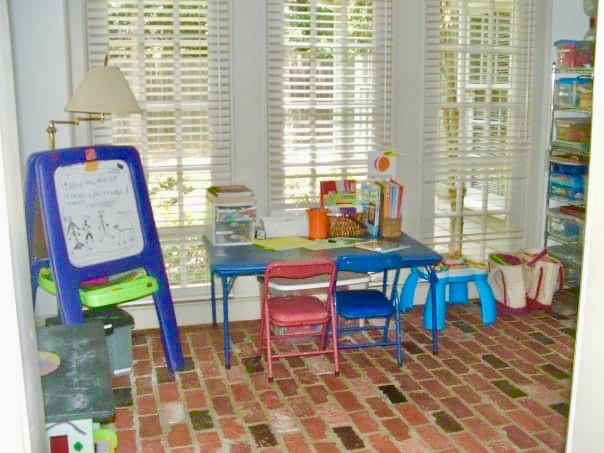
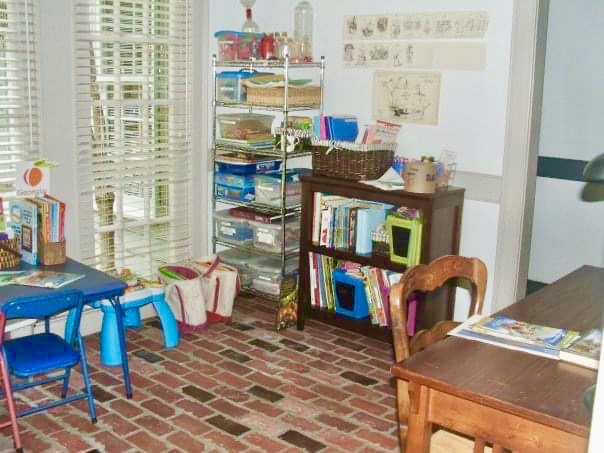

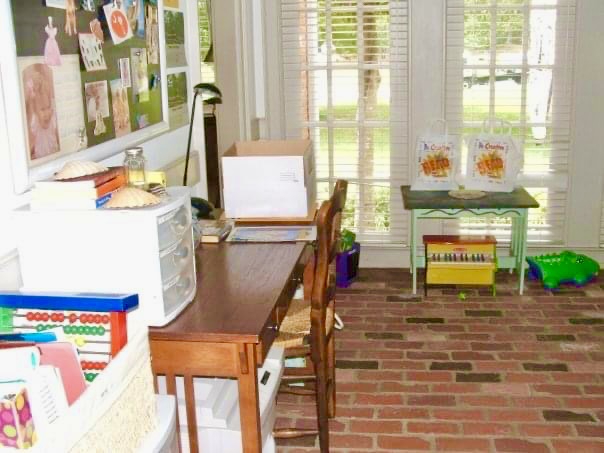
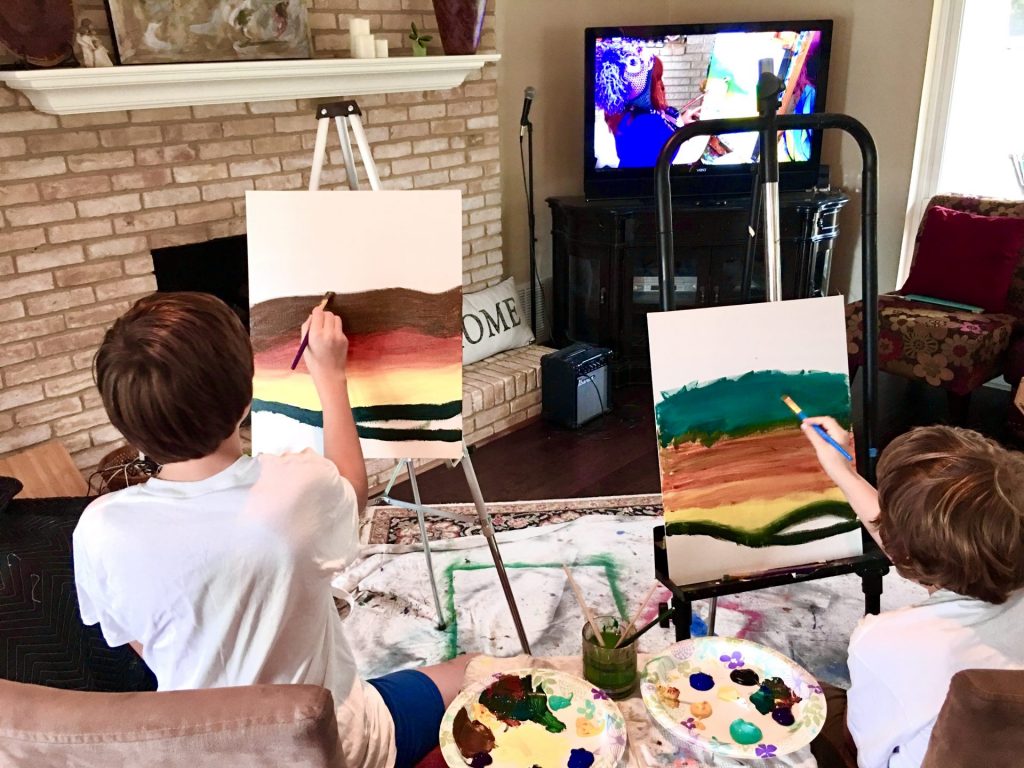
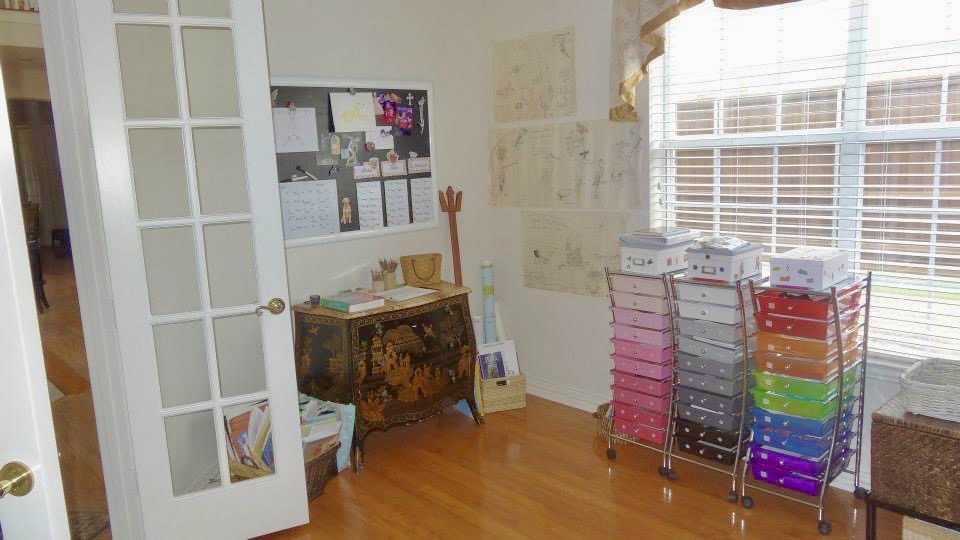
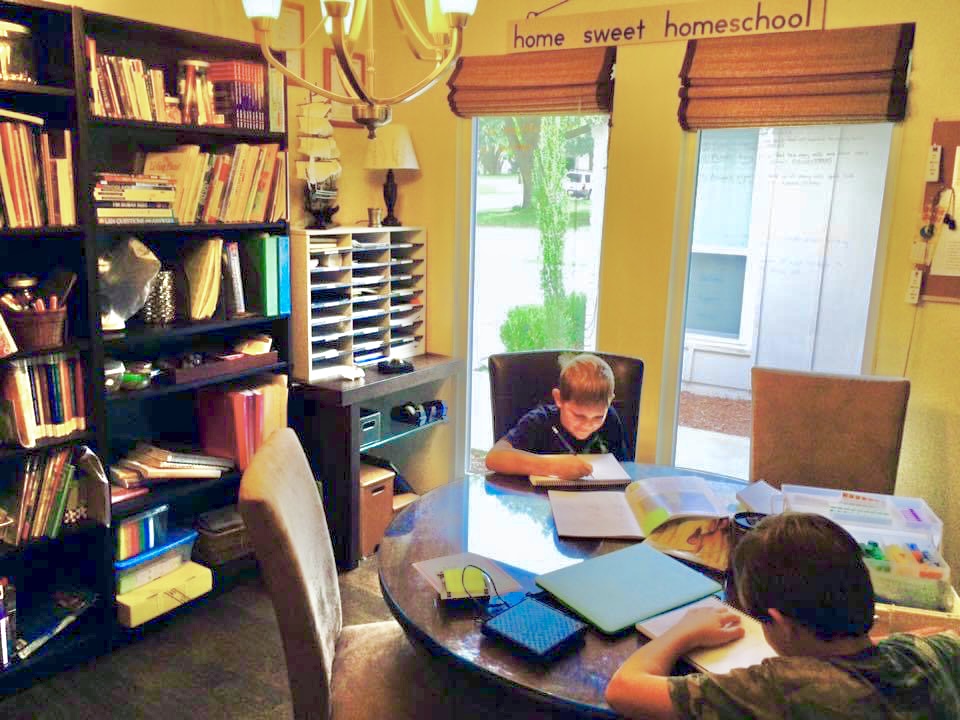
This Week’s Freebie:






